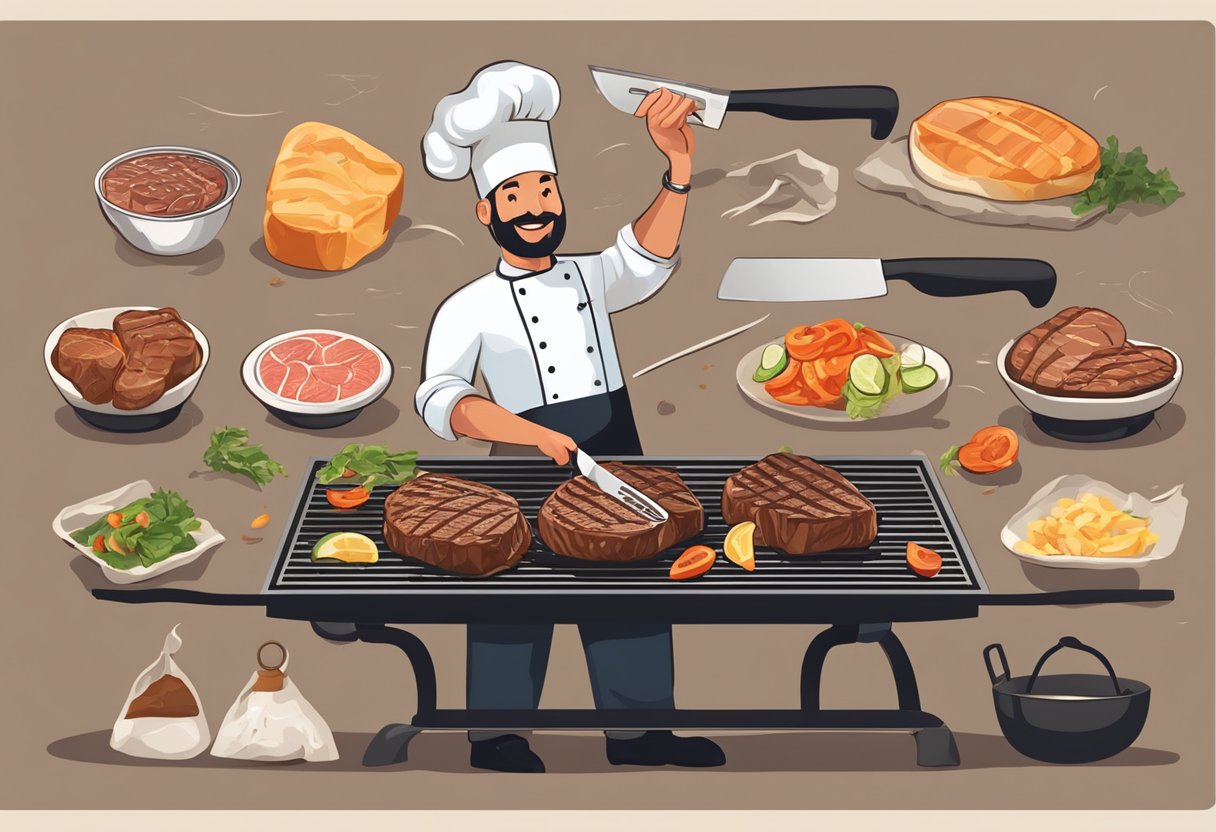Types Of Steak
Steak is a beloved dish enjoyed by many around the world. It is a versatile meat that can be cooked in various ways and paired with a variety of sides. While most people are familiar with popular cuts like ribeye and filet mignon, there are many other types of steak to explore.
Understanding the basics of steak is essential when it comes to selecting and preparing the meat. Steak is a cut of beef that comes from the muscle of a cow. The quality of the steak depends on several factors, including the age and breed of the cow, the cut of meat, and the way it is prepared. Some cuts of steak are more tender and flavorful than others, and each cut requires different cooking techniques to bring out its best qualities.
Popular steak cuts include ribeye, sirloin, tenderloin, T-bone, and porterhouse. Each cut has its unique characteristics, such as marbling, tenderness, and flavor. For example, ribeye is known for its rich, beefy flavor and tenderness, while sirloin is leaner and has a firmer texture. Different cuts of steak are suited for different cooking methods, such as grilling, broiling, or pan-searing.
Key Takeaways
- Understanding the basics of steak is essential for selecting and preparing the meat.
- There are many types of steak to explore beyond popular cuts like ribeye and filet mignon.
- Each cut of steak has its unique characteristics and requires different cooking techniques to bring out its best qualities.
Understanding Steak Basics

Steak Definitions and Categories
Steak is a meat dish that is typically cut across the muscle fibers and cooked by grilling, pan-frying, or broiling. It is a popular food item that is enjoyed by many people around the world. There are various types of steak, and they can be categorized based on the following factors:
- Cut: The cut of a steak refers to the specific part of the animal from which it is taken. Different cuts have different characteristics, such as tenderness, flavor, and fat content.
- Beef Grade: The grade of beef is determined by the amount of marbling (intramuscular fat) in the meat. The higher the grade, the more tender and flavorful the steak.
- Cooking Method: The cooking method used can affect the texture, flavor, and juiciness of the steak.
Some common categories of steak include:
- Tender Cuts: These are the most expensive and highly sought-after cuts of steak. They come from muscles that are not heavily used by the animal and have a high level of marbling. Examples include filet mignon, ribeye, and porterhouse.
- Lean Cuts: These are less expensive cuts of steak that come from muscles that are used more frequently by the animal. They have less marbling and are generally less tender. Examples include sirloin and flank steak.
- Specialty Cuts: These are less common cuts of steak that are typically only found at specialty meat markets or high-end restaurants. Examples include hanger steak and skirt steak.
Cuts of Beef Explained
Understanding the different cuts of beef is essential when it comes to selecting the right cut of steak. The following are some of the most popular cuts of beef and their characteristics:
- Filet Mignon: This is a tender and lean cut of beef that comes from the tenderloin muscle. It is typically the most expensive cut of steak and is known for its buttery texture and mild flavor.
- Ribeye: This cut comes from the rib section of the cow and is known for its rich flavor and high level of marbling. It is a tender cut that is often considered one of the best cuts of steak.
- Sirloin: This is a lean cut of beef that comes from the lower back of the cow. It is less tender than other cuts but has a bold, beefy flavor.
- T-Bone: This cut includes a T-shaped bone with meat on both sides. It comes from the short loin section of the cow and includes both the tenderloin and strip steak.
- Porterhouse: This is a larger version of the T-bone steak and includes a larger portion of the tenderloin muscle. It is typically enough to feed two people.
In conclusion, understanding the basics of steak is essential when it comes to selecting the right cut of beef and cooking it to perfection. By knowing the different categories of steak and the characteristics of each cut, you can make an informed decision when ordering or preparing steak.
Popular Steak Cuts
When it comes to steak, there are many different cuts to choose from. Each cut has its unique flavor, texture, and fat content. In this section, we will discuss some of the most popular steak cuts.
Tenderloin and Filet Mignon
Tenderloin and Filet Mignon are two of the most tender cuts of steak. They are lean and have a mild flavor. Tenderloin is a boneless cut that comes from the short loin. Filet Mignon is a specific cut of tenderloin that is taken from the smaller end of the muscle. Both cuts are often served at high-end restaurants and are considered a luxury item due to their tenderness and price.
Ribeye and Sirloin
Ribeye and Sirloin are two of the most popular cuts of steak. Ribeye is a cut from the rib section of the cow, and it is known for its marbling and rich flavor. Sirloin is a leaner cut that comes from the back of the cow. It has a slightly tougher texture than ribeye, but it is still flavorful and tender.
T-Bone and Porterhouse
T-Bone and Porterhouse are two cuts that are often confused with each other. They both come from the short loin and have a T-shaped bone in the center. The main difference between the two cuts is the size of the tenderloin. Porterhouse has a larger tenderloin than T-Bone, which makes it a more expensive cut of steak.
Flank, Skirt, and Hanger Steak
Flank, Skirt, and Hanger Steak are three cuts that are known for their flavor rather than their tenderness. They are all lean cuts that come from the lower belly of the cow. Flank steak is often used in fajitas, while Skirt and Hanger Steak are popular in Asian and Latin American cuisine. These cuts are best when cooked quickly over high heat and sliced against the grain.
In conclusion, there are many different cuts of steak to choose from, each with its unique flavor and texture. When selecting a steak, consider the cut, marbling, texture, fat content, and whether it is bone-in or boneless. With this knowledge, you can confidently choose the best steak for your taste and budget.
Cooking Techniques and Tips
Grilling Perfection
Grilling is one of the most popular ways to cook steak, and it can be done on either gas or charcoal grills. To achieve grilling perfection, it’s important to start with a clean and well-oiled grill. Preheat the grill to high heat and place the steak on the grill. Avoid moving the steak around too much, as this can cause it to stick to the grill and lose its juices.
For a medium-rare steak, grill the steak for about 4-5 minutes per side. Use a meat thermometer to check the internal temperature and remove the steak from the grill when it reaches 135°F. Let the steak rest for a few minutes before serving.
Seasoning and Marinating
Steak can be seasoned with just salt and pepper, or with a blend of herbs and spices. A dry rub is a great way to add flavor to steak, and it can be made with a variety of spices and herbs. When using a dry rub, be sure to rub it into the steak thoroughly and let it sit for at least 30 minutes before cooking.
Marinades are another way to add flavor to steak. A marinade typically includes an acid, like vinegar or lemon juice, along with herbs and spices. The acid helps to tenderize the meat and the herbs and spices add flavor. Marinate the steak for at least 30 minutes before cooking.
Cookware and Temperature Control
A cast-iron skillet is a great option for cooking steak indoors. Heat the skillet over high heat and add a tablespoon of oil. When the oil is hot, add the steak and sear for 2-3 minutes per side. Finish cooking the steak in the oven at 400°F until it reaches the desired internal temperature.
Temperature control is key when cooking steak. Use a meat thermometer to check the internal temperature of the steak and remove it from the heat when it reaches the desired temperature. Let the steak rest for a few minutes before serving to allow the juices to redistribute.
Steak Selection and Preparation
Choosing the Right Cut
When it comes to selecting the right cut of steak, it’s important to consider factors such as fat content, tenderness, and flavor. Grocery stores and butcher shops offer a variety of cuts, each with its own unique characteristics.
The most tender cuts of steak come from the loin and rib sections, such as filet mignon, ribeye, and New York strip. These cuts are also higher in fat, which contributes to their flavor and tenderness.
Leaner cuts such as sirloin and flank steak have less fat, but can still be flavorful and tender when prepared correctly. These cuts are also a good option for those looking for a healthier option.
Before making a final decision, it’s important to consider how the steak will be prepared. For example, a marinated or tenderized steak may benefit from a leaner cut, while a thicker, more flavorful cut may be better suited for grilling or broiling.
Preparation Before Cooking
Proper preparation before cooking can make all the difference when it comes to achieving a delicious, tender steak. Before cooking, it’s important to let the steak come to room temperature, which can help it cook more evenly.
Additionally, removing excess connective tissue and trimming excess fat can help prevent the steak from becoming tough or chewy. Seasoning the steak with salt and pepper or a marinade can also enhance its flavor.
When it comes to cooking, it’s important to use the right cooking method for the cut of steak. For example, thicker cuts may benefit from a slower cooking method such as roasting, while thinner cuts may be better suited for grilling or broiling.
By selecting the right cut of steak and properly preparing it before cooking, anyone can achieve a delicious, tender steak that is sure to impress.
Serving and Enjoying Steak
When it comes to serving and enjoying steak, there are a few things to keep in mind to ensure the best possible dining experience. Here are some tips and suggestions to help you make the most of your steak.
Accompaniments and Sauces
One of the best things about steak is that it pairs well with a wide variety of accompaniments and sauces. Some popular options include chimichurri sauce, which is a tangy and herbaceous sauce that originates from Argentina and is typically made with parsley, garlic, vinegar, and oil. It pairs well with grilled hanger steak or Santa Maria steak, which are both flavorful and tender cuts of beef.
Another great option is to serve your steak with a classic béarnaise sauce, which is a rich and creamy sauce made with egg yolks, butter, tarragon, and shallots. This sauce is a great choice for entrecote or chateaubriand, which are both tender and luxurious cuts of beef that are perfect for special occasions.
Presentation and Slicing
In addition to the accompaniments and sauces, presentation and slicing are also important factors to consider when serving steak. For example, when grilling a steak, it’s important to let it rest for a few minutes before slicing it to allow the juices to redistribute throughout the meat. This will help to ensure that the steak is juicy and flavorful.
When it comes to presentation, there are many different options to choose from. Some people prefer to serve their steak whole, while others like to slice it and arrange it on a platter. You can also add garnishes such as fresh herbs or sliced vegetables to add color and flavor to the dish.
Overall, serving and enjoying steak is all about finding the right balance of flavors and textures. By choosing the right accompaniments and sauces, and paying attention to presentation and slicing, you can create a delicious and memorable dining experience that is sure to impress your guests.






